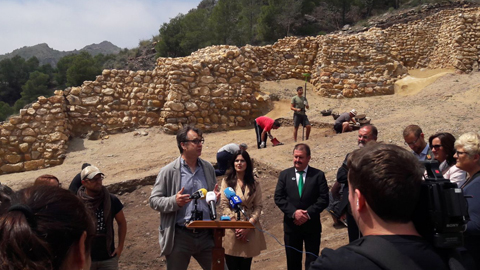UAB Team Launches New Digs at La Bastida with Support from National Geographic Society

11/05/2018
How was the large fortified wall at La Bastida built on such difficult terrain? Was it surrounded by a moat? Was it witness to gruesome combats? What role did the force of weapons play in the formation of the Argaric culture, which extended from the shores of the Mediterranean to more inner regions of modern-day Spain?
These are some of the questions the Research Group in Mediterranean Social Archaeoecology (ASOME) of the Universitat Autònoma de Barcelona (UAB) hopes to answer with a new archaeological excavation, which is funded by a grant from National Geographic Society.
The project was presented at the site of La Bastida (Totana, Murcia) by Eva Celdrán, María Inés Fregeiro, Miguel Valério, Carlos Velasco and Roberto Risch, all researchers at the UAB, with the attendance of representatives of the Regional Government of Murcia and the Totana City Council.
In this new research phase, the work of the “La Bastida Project” will focus mainly on the foot of the external wall, particularly on uncovering and documenting all the structural elements of this monumental feat. This is, according to researchers, a key step towards understanding the military knowledge of El Argar and look for connections with other societies that already possessed this building experience.
The excavation and research project, which sees the participation of some fifteen specialists, began recently and will last for three months.
In addition to the financial aid of the National Geographic Society, the UAB team in charge will have the cooperation of the Totana City Council and the Friends of the La Bastida Archaeological Site Association (ASBA).
The team has been working at the site of La Bastida (Totana, Murcia) for ten years now, revealing what could be a real “lost civilisation” on European territory: the El Argar culture, one of the first states of the Bronze Age (2200-1550 BC), with La Bastida as its most important capital.
In 2012, they found a monumental fortification system which protected the city and is the first of its kind dating to this period of European prehistory. The importance of the discovery reopened debates surrounding the idea that the first Old World civilizations emerged only in the East and the beginnings of militarized violence in Europe. It also led to new hypotheses on how this society expanded throughout large areas in the southeast of the Iberian Peninsula.
In the past decade, researchers have also conducted several conservation, restoration and musealization tasks, as well as documenting and investigating all findings. The previous dig campaign ended five years ago.
Top: General view of the La Bastida site (Totana, Murcia). Bottom: Part of the La Bastida fortification discovered in 2012, with all excavation and documenting tasks of this new research campaign taking place at the foot of the wall. Author: ASOME.
War and Civilization
The city of La Bastida occupies a small hill hidden by larger mountains and surrounded by cliffs. This protected area was chosen to rule over much of the modern-day provinces of Murcia and Almeria.
The discoveries made in 2012 indicated that the Argaric culture had come into being during a period of conflict.
At the fortification, the team of archaeologists identified two lines of wall and several defensive towers, alongside an ingenious entrance corridor, which revealed that the first inhabitants of the city possessed sophisticated architectural and engineering knowledge. This sophistication is highly unusual for prehistoric Western Europe and implies the work of a group of people specialized in the use of violence.
Scattered fragments of human remains were also found throughout the entrance corridor of the city. This feature, along with the combat weapons (halberds and daggers) found in warrior graves at several sites, opens the possibility of conquest wars that expanded the Argaric rule to inner Iberia.
Continuing with the excavations will allow researchers to delve deeper into the details of how and why those first bellicose encounters took place, and in this way pinpoint the beginnings of militarized violence in Western Europe.
Links:
http://www.la-bastida.com/inicio/index.html
http://www.ruta-argarica.es/